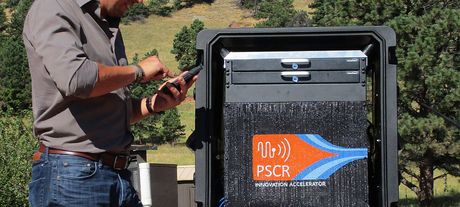Rolling wireless net improves emergency comms

Plug in NIST’s Rapidly Deployable Public Safety Research Platform, switch it on and start making calls within minutes.
First responders often have trouble communicating with each other in emergencies. They may use different types of radios, or they may work in rural areas lacking wireless coverage, or they may be deep inside large buildings that block connections.
To demonstrate improvements to emergency communications and foster research on systems that can be quickly placed in strategic locations, the US National Institute of Standards and Technology (NIST) has worked with industry partners to integrate commercial technologies into a mobile wireless communications system. About the size of a filing cabinet, the platform offers more capabilities and faster set-up than typical ‘cell on wheels’ systems.
NIST’s Rapidly Deployable Public Safety Research Platform enables more than 200 local users of broadband smartphones, Wi-Fi, data terminals and two-way radios to communicate with each other using voice, text, instant messages, video and data. The range is about 4 kilometres in a rural environment.
Crucially, the system interconnects LTE with the public safety community’s traditional LMR systems. The USA’s estimated 5 million public safety personnel are expected to use a mix of both systems. LTE data transmission rates are 30 to 1000 times higher than LMR.
“The portable system was built to enable research in diverse environments,” said Tracy McElvaney, an engineering supervisor in NIST’s Public Safety Communications Research (PSCR) Division. “But it is modelled after FirstNet’s image of a vehicle-borne network system and the public safety community’s vision of a rapidly deployable system to be used when the nationwide network is not available.
“Our role at NIST is not to develop the technology itself, but to integrate the state-of-the-art pieces into a conceptual platform that will help drive the industry to meet public safety needs — that is, to make portable systems smaller, more robust and with more capabilities,” McElvaney said.
NIST’s research and demonstration platform was developed through PSCR’s Broadband Consortium, in which more than 70 vendors provide equipment and support. PSCR staff use the system for research projects such as evaluating how to improve audio intelligibility amid crowds and background noise and the development of a database of communications in high-stress, loud-noise environments.
The platform enables research into factors considered critical to the public safety mission, such as how to establish push-to-talk capabilities over broadband systems.
PSCR staff recently tested the system at a convention centre and a stadium in Harris County, Texas, an early adopter of LTE technology for public safety.
“Typically, it takes on the order of hours to deploy a ‘cell on wheels’ system to provide coverage at an event, and multiple deployable systems are needed to enable both LTE and LMR,” McElvaney said. “Our system provides LTE, LMR, video and data. We rolled the system from the vehicle into the building, and once connected to an AC power outlet, we were making calls in less than five minutes.”
The mobile system can also be connected to the internet, satellite or a commercial cellular network to link users to a broader community. PSCR staff are currently exploring integrating sensor data and analytics into the system and developing requirements for linking up with both personal area networks that are already in place as well as temporary Incident Area Networks, which are created as needed and can expand as an incident grows in size and complexity.
NIST has Cooperative Research and Development Agreements (CRADAs) with the partners contributing to the mobile platform. CRADAs are the principal mechanism used by US federal labs to engage in collaborative efforts with non-federal organisations and allow the exchange of resources with private industry to advance technologies that can then be commercialised.
The mobile net is just one of a number of deployable systems PSCR plans to evaluate and leverage for research. Others include backpack systems that can rapidly serve a small team of users, vehicle-mounted systems and perhaps airborne systems.
The work was funded, in part, by the US Department of Homeland Security’s First Responder Group.
The new wildfire reality: mapping a response
Firefighter-turned-researcher Chris Dunn is helping pioneer data-driven solutions to tackle...
ARCIA update: LMR is not dead yet
Be it mining, rail, public safety, transport or utilities, everyone is embracing new technology...
Towards 1 Tbps throughput using sub-terahertz bands
In order to enable the near-instantaneous communication promised by 6G, ultrahigh data speeds...






